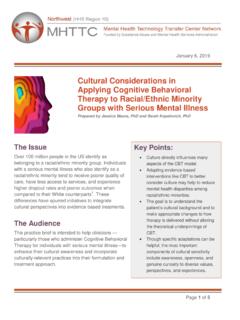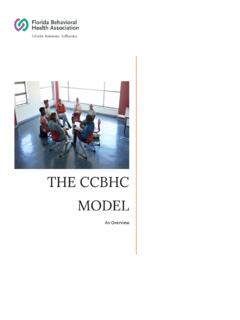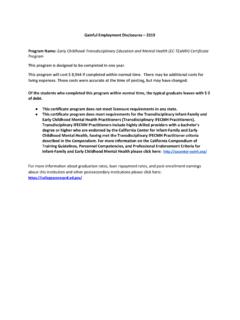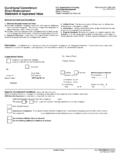Transcription of D U R I N G & A F T E R C O V I D - 1 9 B E H A V I O R A ...
1 BEHAVIORAL HEALTH IMPACTS. DURING & AFTER COVID-19. What to Expect and Ways to Prepare for the Return to In-Person Learning April 2021. OVERVIEW. After over a year of the global pandemic and with the availability of vaccines, schools are now returning to hybrid learning or all in-person learning. This document is an update by the University of Washington School Mental Health Assessment, Research, and Training (SMART) Center, Seattle Children's Hospital, and the Center on Positive Behavioral Interventions & Supports (PBIS) to an initial checklist that was provided to Washington's State Education Agency in June 2020. This update includes new information gleaned about the youth mental health crisis, as well as additional recommendations and considerations to keep in mind as schools bring students back into the school building in a way that prioritizes everyone's mental health and wellness.
2 This document presents information on (1) what has happened in the last year, (2) what to expect as students return to school, and (3) ways to prepare at the staff, building, and district levels. This document is not intended to be an exhaustive list of all school mental health strategies or used in the place of direct consultation with mental health providers. Instead, it should help guide you and your school and district teams to consider an array of strategies and supports for students, families and staff. If you or others in your school, district, or jurisdiction have specific questions about the guidance in this document, your return to school plans, and/or your long-term approach to supporting the social-emotional needs of students please free to contact the SMART Center's Training and Technical Assistance team at Table of Contents TOPIC PAGE.
3 What is Happening 3. What to Expect 4-5. Recommendations for Preparing for Return to School Staff & Building Level 6. District Level 7-9. Resources 10. Where to Find Training & TA 11. "We need to be prepared when we reopen schools to ensure that social and emotional supports are a bigger part of the whole experience - not just this spring but moving forward. We really need to think about how social and emotional learning and mental health support that our students need is the foundation of the programs that we provide and the schools that we use to serve our students.". Dr. Miguel Cardona, Secretary of Education 2. What is Happening? At the start of the pandemic, the Washington Department of Health forecasted (based on models derived from population-level responses to disasters) that impacts from the COVID-19 outbreak and related government actions will likely cause a surge in behavioral health symptoms across the state.
4 Locally and nationwide, data indicates these predictions have come to pass: According to Census data, weekly surveying shows that symptoms of anxiety and depression have increased gradually for all Washington adults, to approximately 20% higher than pre-COVID levels. UW Medicine reports that, for patients under 27 years old, depression diagnoses have increased approx. 30%. since 2019, and nearly 50% for anxiety diagnoses. According to the CDC, nationally, the proportion of emergency visits for mental health issues for youth 12-17. increased by 31% during the pandemic. This trend has also been found at state inpatient facilities such as Swedish, Seattle Children's, and Mary Bridge Children's Hospitals. A CDC report from June 2020 found that mental health conditions are disproportionately affecting young adults (aged 18-24). One in four young adults was found to have seriously considered suicide an increase from one in 10 young adults pre-pandemic.
5 From June 2020 to February 2021, the CDC found that the percent of young adults (aged 18-29) experiencing symptoms of depression or anxiety rose from 49% to 57%. The percent of young adults reporting an unmet need for mental health services rose from 16% to 22%. The CDC has released new vital statistics data on causes of death for all individuals in 2020. Not surprisingly, overall mortality increased While suicide deaths were down overall, rate of death due to unintentional injury (which includes drug overdose) increased A more recent report confirmed that, nationwide and in Washington, drug overdoses in 2020 showed the largest single-year increase in over 20 years. As summarized by The Commonwealth Fund, the final 2020. total in the United States could exceed 90,000 overdose deaths, compared to 70,630 in 2019. Preliminary data show a 35% increase in Washington State.
6 This figure from the Washington Department of Health presents a projection of behavioral health patterns in response to COVID-19, based on responses typical to disasters. WA DOH provides monthly updates on statewide behavioral health impacts from the COVID-19. pandemic as well as updates to its forecasts: ies/COVID19/HealthcareProviders/. BehavioralHealthResources Figure 1: Phases of reactions and behavioral health symptoms in disasters. The dotted graph line represents the response and recovery pattern that may occur if the full force of a disaster cascade is experienced by the majority of the population. Protective factors are characteristics, conditions, or behaviors that reduce the effects of stressful life events. They also increase a person's ability to avoid risks or hazards, recover, and grow stronger. Adapted from the Substance Abuse and Mental Health Services Administration (SAMHSA).
7 3. What to Expect According to the Washington Department of Health, disaster recovery will move from the phase of disillusionment to reconstruction and recovery during the second quarter of 2021. It is important to recognize, however, that communities and individuals who have had more negative experiences (children and young adults, front-line workers, persons of color, individuals with lower incomes and/or employment disruptions) will likely move more slowly into recovery phases and are more likely to experience more severe behavioral health symptoms (see figure 1 above). Multiple additional disasters, such as COVID-19 variants, could contribute to a disaster cascade including sources of mental health distress and disparity that intersect with COVID impacts ( , racism and racial trauma, vaccine inequities, loss of employment and income, etc.)
8 The effects of isolation combined with shifting educational and social opportunities and experiences have contributed to greater behavioral health challenges for individuals ages 6 25. As indicated from the statistics above, children, teens, and young adults are a group of particular concern, demonstrating symptoms and suicidal ideation at nearly twice the rate of adults 40 and older. General fatigue, exhaustion, and feeling overwhelmed are common experiences, as are sleep problems, diminished cognitive and high level thinking, memory challenges, and increased impacts of existing behavioral health symptoms such as depression, anxiety, or trauma. For youth, teens, and young adults, Pandemic Apathy is likely to be widespread, including acting out . (denial/ignoring consequences) and acting in (extreme hopelessness/not engaging). An increase in youth risk oriented behaviors in the spring and summer may also manifest due to the degree of psychological impact those groups have experienced, and lessening of restrictions.
9 Substance use issues may be impacted and substance-related disorders may increase. Approximately half of the individuals who experience a behavioral health diagnosis will develop a substance-related disorder, and vice versa. As a result, we can expect substance-related symptoms and disorders to increase as behavioral health symptoms and disorders increase. This will be true of adolescents as well as parents/caregivers. Among young adults aged 18-24, the CDC reports that, as of August 2020, 25% started or increased substance use to cope with pandemic-related stress or emotions, far higher than any other age group. This is only likely to have increased in the interim. The return to in-person learning can cause distress, both for the student who has disengaged or has many missing assignments and for the student for whom remote learning has been a positive experience and is excelling.
10 Additionally, students may experience disappointment when returning to the building and school doesn't feel the same due to distancing and safety protocols. Children/youth with pre-existing anxiety about school may have experienced decreased anxiety during remote learning, but will likely experience increases upon returning after prolonged absence. Some students may have anxiety related to fears of getting sick (from COVID or something else) or their loved ones getting sick. Some will have experienced losses (deaths, prolonged hospitalizations, isolation from loved ones) that lead to grief or ongoing worry about a family member. Loss of school activities and disrupted social networks and friendships will likely be linked to increases in depressive symptoms and possibly suicidality. Some students, especially those not actively engaged in remote learning, may have anxiety about their ability to successfully re-engage and overcome missed learning.











